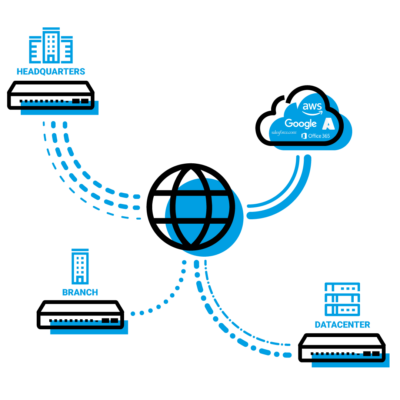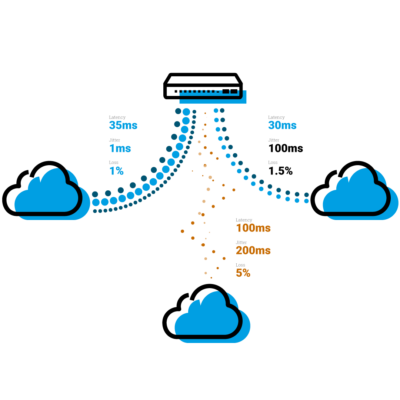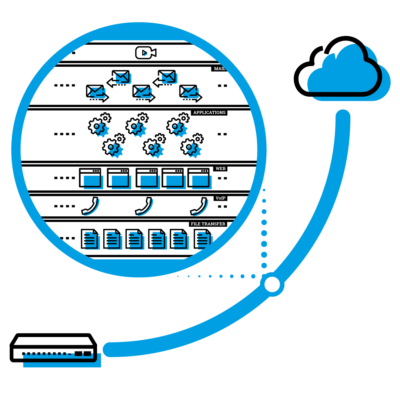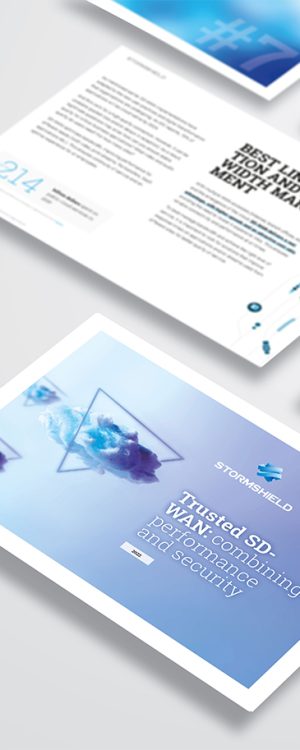Control of your interconnections
SD WAN (Software Defined Wide Area Network) enables optimised and automated management of WAN links, reducing costs and improving network resilience.
Stormshield's Trusted SD-WAN offers greater flexibility for businesses and organisations: it analyses the performance of individual WAN links in real time and automatically adjusts traffic distribution according to business priorities. This approach ensures optimal service continuity and reduced latency.
Automatic
distribution
of the load
Set of
software
features


Dynamic link selection
Using advanced algorithms, SD-WAN technology dynamically selects the best available link based on latency, throughput and corporate policies.
Stormshield's Trusted SD-WAN incorporates continuous monitoring of network indicators (latency, jitter, packet loss) and automatically adapts routing to ensure optimum quality of service. In the event of a link degradation, an automatic and transparent failover is performed to ensure service continuity.
Measurement of
the quality
of the link
Automatic switching according to the measured criteria
Monitoring
metrics
for links
Ease of bandwidth management
The Quality of Service (QoS) of Stormshield Network Security solutions prevents network congestion and ensures 100% reliable connectivity. This ensures uninterrupted connectivity and an optimal user experience.
Increased
bandwidth
on the network
Guaranteed
availability
of the network
No loss
of productivity

Trusted, secure SD-WAN solutions that comply with European requirements
Unlike many SD-WAN vendors that focus solely on connectivity, Stormshield natively integrates advanced security into its approach to SD-WAN.
Our range of Stormshield Network Security (SNS) firewalls, our centralised management console Stormshield Management Center (SMC) and our log management solution Stormshield Log Supervisor (SLS) form the foundation of our secure and trusted SD-WAN approach and ensure end-to-end protection against cyber threats.
With high-level European qualifications and certifications, Stormshield enables you to deploy a Trusted SD-WAN and meet the most stringent compliance requirements.
Optimised, intelligent management
of your SD-WAN network
Intelligent distribution of Internet traffic
& automatic failover mechanism
Easy deployment of equipment
at your remote sites
Centralised management from
our SMC and SLS solutions (or via API)
The advanced features of Stormshield's trusted SD-WAN also include:
- Management of secure VPN tunnels for encrypted communication between remote sites
- Recognition of web applications (SaaS)
- Intelligent routing of flows by application and protocol
- Bandwidth management (QoS)
- Monitoring of the link quality by SLA indicators (latency, jitter, packet loss)
- Centralised administration of security policies
Contact Stormshield teams
SD-WAN is a catch-all term that can seem complex. Our teams of experts are on hand to help you understand the different models and types of SD-WAN, and answer any questions you may have. Are you ready to move to a trusted SD-WAN? Take advantage of expert support to get precise answers tailored to your network and cybersecurity challenges.
How to select a trusted, secure and reliable SD-WAN?
When it comes to selecting a vendor from among a number of hardware and software solutions, you need to consider, among other things, the product's robustness and trustworthiness in relation to geopolitical and economic issues. The notion of robustness is defined by the ANSSI as an evaluation of products that "consists of testing their ability to resist computer attacks according to a defined context of use and level of threat". The notion of trust is to be found clearly in the product strategy of the various publishers. When choosing an SD-WAN solution, a number of criteria need to be assessed:
- Robustness to face cyber threats, in line with ANSSI recommendations;
- Confidence in the technology, developed in line with sovereignty issues;
- Performance and flexibility, to enable scalability in line with your needs;
- Seamless integration, in line with the challenges of protecting your data and segmenting the network.
To help you choose your future SD-WAN, there are four key aspects to bear in mind: performance, cost, security and trust. Our exclusive white paper helps you to see things more clearly, deciphers the strategic challenges of SD-WAN and guides you through the implementation of an optimised and secure network architecture. Aimed at consultants and IT security managers, it provides a detailed analysis of best practice and the essential criteria to be taken into account.
Q&A: What is SD-WAN? SD-WAN is an acronym for ‘Software-Defined Wide Area Network’. This technology simplifies the management of networks at different sites, while optimising costs. It is an innovative way of improving performance and unifying network connectivity, including the hybrid cloud. As such, it is an essential pillar for keeping pace with structural and digital changes in businesses and organisations, offering their employees and customers a better experience, as well as improvements in their IT connections and processes.
Q&A: How does SD-WAN work? The way SD-WAN works is simple: it allows you to select the best link for the different flows by analysing latency, jitter and packet loss, for example. At the same time, to better adapt the bandwidth to the flows, it is possible to reserve it, for example, to prioritise inter-site communications. On the other hand, limiting bandwidth allows better management of Internet traffic usage. With multiple WAN accesses (Internet, branch offices, etc.) and the emergence of the cloud, SD-WAN offers a real advantage, with higher speeds and an attractive cost ratio, avoiding the need to invest in expensive links.
Q&A: What are the benefits of SD-WAN? SD-WAN stands out from traditional WANs and offers a number of advantages: network optimisation, improved performance, enhanced security and reduced costs. In other words, SD-WAN enables businesses and organisations to adapt and manage network and Internet traffic using centralised policies based on several criteria (such as application, user, time of day, etc.). The result is a faster, more reliable SD WAN.



